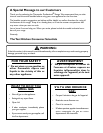
PRG Professional Ranges Care and Use Section One: General Safety Instructions
PRECAUTIONS
Page 5
Warning: The appliance is for
cooking. Based on safety consider-
ations, never use the oven or
cooktop to warm or heat a room.
Also, such use can damage the
cooktop or oven parts.
When using the cooktop: DO
NOT TOUCH THE BURNER
GRATES OR THE IMMEDI-
ATE SURROUNDING AREA.
Areas adjacent to the burners may
become hot enough to cause burns.
Never leave the cooktop unat-
tended when using high flame
settings. Boil overs cause smoking
and greasy spillovers that may ig-
nite. More importantly, if the
burner flames are smothered, un-
burned gas will escape into the
room. See Inside Front Cover re-
garding gas leaks.
Only certain types of glass,
heat-proof glass-ceramic, ce-
ramic, earthenware, or other
glazed utensils are suitable for
cooktop use. This type of utensil
may break with sudden tempera-
ture changes. Use only on low or
medium heat settings according to
the utensil manufacturer’s direc-
tions.
Do not heat unopened food
containers; a buildup of pressure
may cause the container to burst.
During cooking, set the burner
control so that the flame heats
only the bottom of the pan and
does not extend beyond the
bottom of the pan.
Use caution to insure that
drafts like those from forced
air vents or fans do not blow
flammable material toward
the flames or push the flames
so that they extend beyond the
edges of the pot.
Be sure all cooktop controls
are turned off and the cooktop is
cool before using any type of aero-
sol cleaner on or around the
cooktop. The chemical that pro-
duces the spraying action could, in
the presence of heat, ignite or
cause metal parts to corrode.
When using the oven: DO NOT
TOUCH THE INTERIOR
SURFACES OF THE OVEN
OR THE EXTERIOR AREA
IMMEDIATELY SURROUND-
ING THE DOOR. Interior oven
surfaces become hot enough to
cause burns. The heat deflector,
which deflects heat away from the
cooktop and the trim on the top
and sides of the oven door, will also
be hot when the oven is in use.
Place oven racks in desired po-
sition while oven is cool. If a rack
must be moved while the oven is
hot, do not let the potholders con-
tact the hot infrared burner.
Use care when opening the
oven door; let hot air or steam
escape before removing or replac-
ing foods.
Do not rub, damage, move or
remove the door gasket. It is
essential for a good seal during
baking.
Be careful not to damage the
screen covering the infra-red
broiler of the gas oven. If the
screen is damaged, air can enter the
distribution box behind the screen,
possibly resulting in an explosion.
In the event that personal
clothing catches fire, DROP
AND ROLL IMMEDIATELY
to extinguish flames.
Always use utensils that have
flat bottoms, large enough to
cover the burner. The use of un-
dersized utensils could expose a
portion of the flame and may result
in ignition of clothing.
To minimize burns, ignition of flam-
mable materials and unintentional
spillovers, position handles of
utensils inward so they do not
extend over adjacent work areas,
cooking areas, or the edge of the
cooktop.
Hold the handle of the pan to
prevent movement of the utensil
when stirring or turning food.
DO NOT use pots or pans on
the grill section.
Do not use the grill for cooking
excessively fatty meats or prod-
ucts which promote flare-ups.
The optional cutting board ac-
cessory must be removed be-
fore operating the grill burner
beneath or burners adjacent to
it.
GREASE IS FLAMMABLE. Let
hot grease cool before attempting
to handle it. Avoid letting grease
deposits collect. Clean after each
use.
For proper lighting and perfor-
mance of the burners, keep the
igniter ports clean. It is necessary
to clean these when there is a boil
over or when the burner does not
light even though the electronic ig-
niters click. See page 12.
Clean the cooktop with cau-
tion. Avoid steam burns; do not
use a wet sponge or cloth to clean
the cooktop while it is hot. Some
cleaners produce noxious fumes if
applied to a hot surface. Follow
directions provided by the cleaner
manufacturer.
Safety Practices to Avoid Personal Injury


















